From Bulbapedia, the community-driven Pokémon encyclopedia.
|
|
| Line 183: |
Line 183: |
| * The newer Pokémon of each ecologically similar pairing always has a type that is strong against the original counterpart's typing. For example, the Water type of Wiglett's line is strong against Diglett's line, which is Ground type. | | * The newer Pokémon of each ecologically similar pairing always has a type that is strong against the original counterpart's typing. For example, the Water type of Wiglett's line is strong against Diglett's line, which is Ground type. |
| ** This is true for Poltchageist's line as well, despite sharing a type with their counterparts, since Ghost-type moves are super effective against Ghost-type Pokémon. | | ** This is true for Poltchageist's line as well, despite sharing a type with their counterparts, since Ghost-type moves are super effective against Ghost-type Pokémon. |
| | * The Pokédex entries for {{p|Cetoddle}} mention that it is closely related to {{p|Wailmer}}; however, they are not considered ecologically similar by other sources in the way the other pairings are. |
|
| |
|
| ===Origin=== | | ===Origin=== |
Revision as of 07:58, 5 November 2023

|
The subject of this article has no official name.
The name currently in use is a fan designator; see below for more information.
|
Certain Pokémon are described as ecologically similar[1] (Japanese: 生態は似ている[2] ecologically similar) to previously discovered species, but are otherwise completely different Pokémon. This concept was first introduced in Generation IX.
They are sometimes referred to by fans as convergent forms, convergent Pokémon, or convergent species, relating the concept to convergent evolution in biology, or regional fakes, due to their similarity to regional forms, which are different forms of the same Pokémon. So far, six of these Pokémon have been introduced. Jacq is known for his research on these Pokémon in collaboration with the World Pokémon Ecological Society.[3]
Ecologically similar Pokémon tend to have similar, though not always identical, base stats.
In the core series games
In Pokémon Scarlet and Violet, the player can find Pokémon that are ecologically similar to other species across Paldea, as well as in Kitakami.
History
These Pokémon were first identified by the World Pokémon Ecological Society after the discovery of Wiglett during a survey.[3] Wiglett was initially mistaken as a possible Paldean form of Diglett before it was decided that it was a different species entirely and the similarities were merely coincidental.
List of ecologically similar Pokémon
| Ecologically Similar Pokémon
|
| Ndex
|
Newer Pokémon
|
Ecology
|
Ndex
|
Original Counterpart
|
Ecology
|
| #0948
|

Toedscool
Ground Grass
|
- Inspiration: Wood ear mushroom
- Habitat: Forests
- Body: Edible mushroom
- Diet: Clings to tree roots
- Behavior: Jumps around, can run at a speed of 30 mph
|
#0072
|
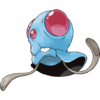
Tentacool
Water Poison
|
- Inspiration: Jellyfish
- Habitat: Shallow seas
- Body: Virtually composed of water and can regenerate
- Diet: Constricts and poisons its prey
- Behavior: Drifts in sea currents and alerts others by flashing its orbs
|
| #0949
|

Toedscruel
Ground Grass
|
- Inspiration: Wood ear mushroom
- Habitat: Forests
- Body: Edible mushroom, has 10 tentacles
- Diet: Constricts its prey and sucks out their nutrients
- Behavior: Jumps around and dislikes strangers
|
#0073
|
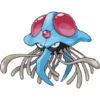
Tentacruel
Water Poison
|
- Inspiration: Jellyfish
- Habitat: Complex rock formations on the ocean floor
- Body: Virtually composed of water, can regenerate, has 80 tentacles (most are hidden)
- Diet: Constricts and poisons its prey
- Behavior: Alerts and weakens others by flashing its orbs
|
| #0960
|
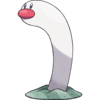
Wiglett
Water
|
- Inspiration: Garden eel
- Habitat: Coastlines and seas
- Body: Stretchy, gooey feel, and it is unknown what it looks like under the sand
- Diet: Unknown
- Behavior: Hides in the sand when sensing danger
|
#0050
|
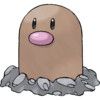
Diglett
Ground
|
- Inspiration: Mole
- Habitat: Tunnels and caves under the earth, also resides in forests
- Body: Thin skin, it is unknown what it looks like under the ground, but likely has clawed limbs
- Diet: Plant roots
- Behavior: Toils and manures the soil perfectly and dislikes the sunlight
|
| #0961
|
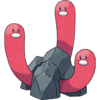
Wugtrio
Water
|
- Inspiration: Garden eel
- Habitat: Coastlines and seas
- Body: Stretchy and gooey, triplets sharing one body, and is unknown what it looks like in the rock
- Diet: Wraps around its prey and drags it to its den
- Behavior: Vicious temperament and hides from humans
|
#0051
|
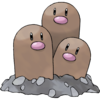
Dugtrio
Ground
|
- Inspiration: Mole
- Habitat: Tunnels and caves under the earth, also forests
- Body: Triplets sharing one body, it is unknown what it looks like under the ground, but likely has clawed limbs
- Diet: Each head fights over who gets to eat first
- Behavior: Toils and manures the soil perfectly, burrows rapidly, causing earthquakes, and attacks unexpectedly on occasion
|
| #1012
|

Poltchageist
Grass Ghost
|
- Inspiration: Living or possessed matcha inhabiting a tea caddy
- Habitat: Old houses in towns and their outskirts
- Body: Powdery, its swirl pattern is not a weak point
- Diet: Drains the energy of those who touch or ingest its powder
- Behavior: Nocturnal, tends to scatter matcha powder to fix broken objects, and attacks anyone who breaks things
|
#0854
|
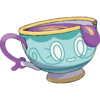
Sinistea
Ghost
|
- Inspiration: Possessed tea inhabiting a teacup
- Habitat: Hotels and houses
- Body: Liquidy, the swirl pattern is its weakness, tastes awful
- Diet: Absorbs the life force of those who drink it
- Behavior: Patiently waits for its victims
|
| #1013
|

Sinistcha
Grass Ghost
|
- Inspiration: Living or possessed matcha inhabiting an Unremarkable or Masterpiece Teacup
- Habitat: Dark places, such as the back of a shelf or the space beneath a home's floorboards
- Body: Powdery
- Diet: Drains the life force of those who drink it
- Behavior: Searches for preys after sunset and pretends to be tea, trying to fool people into drinking to drain their life force
|
#0855
|

Polteageist
Ghost
|
- Inspiration: Possessed tea inhabiting a Cracked or Chipped Pot
- Habitat: Hotels and houses
- Body: Liquidy and has a distinct and enjoyable flavor
- Diet: Absorbs the life force of those who drink it
- Behavior: Patiently waits for its victims
|
|
|
Descriptions
The relationships between ecologically similar Pokémon have been described in Pokédex entries and other sources.
| Pokémon
|
Description
|

Toedscool
|
Pokédex entry from Pokémon Violet:
- Though it looks like Tentacool, Toedscool is a completely different species. Its legs may be thin, but it can run at a speed of 30 mph.
|

Wiglett
|
Pokédex entry from Pokémon Violet:
- Though it looks like Diglett, Wiglett is an entirely different species. The resemblance seems to be a coincidental result of environmental adaptation.
Jacq's memo from the World Pokémon Ecological Society conference:
- This Pokémon that lives on the beach or in the sea of the Paldea region would be Wiglett. Although they appeared to be the Paldean Form of Diglett, we've learned that they live and eat differently as if they are entirely different Pokémon. According to the research, it is said that it is a coincidence that they have similar bodies, as they both burrow in the ground and the sand.
Official Pokémon Scarlet and Violet website:[4]
- It’s said that Wiglett’s resemblance to Diglett might be a mere coincidence—a result of its adaptation to its environment.
- Though It May Closely Resemble Diglett, It’s a Completely Different Pokémon: It may look like Diglett, but it’s actually a completely different species of Pokémon. Wiglett pokes a part of its body out of the sand to feed in the ocean. It’s still unclear what the rest of its body hidden in the sand is like or how long it might be.
|

Wugtrio
|
Pokédex entry from Pokémon Violet:
- A variety of fish Pokémon, Wugtrio was once considered to be a regional form of Dugtrio.
|

Poltchageist
|
Pokédex entry from Pokémon Violet:
- Poltchageist looks like a regional form of Sinistea, but it was recently discovered that the two Pokémon are entirely unrelated.
Official Pokémon Scarlet and Violet website:[1]
- It may resemble Sinistea at a glance, but Poltchageist is actually an entirely different species of Pokémon.
- Though Ecologically Similar to Sinistea, It’s a Completely Different Pokémon: Poltchageist has a swirl pattern similar to the one that’s known to be Sinistea’s weak point. However, one thing that sets these species apart is that Poltchageist’s swirl is not its weak point. After a target is sprinkled with some of Poltchageist’s powdery body or eats food dusted with it, Poltchageist drains their life-force and absorbs it as energy.
|
Base stats comparison
Trivia
- The concept of ecologically similar Pokémon was first introduced with the reveal of Wiglett before the release of Pokémon Scarlet and Violet.[3]
- These Pokémon are similar to the Paradox Pokémon in that they bear a striking resemblance to certain Pokémon but are nonetheless completely different species.
- These Pokémon are all part of a two stage evolution line.
- Some ecologically similar Pokémon have several unique distinctions:
- The Poltchageist and Sinistea families are the only ecologically similar Pokémon that share a type and the only ones to share Egg Groups with each other.
- Additionally, they are the only ones which are named after the inverse of their counterparts, with Poltchageist's evolved form Sinistcha being named after Polteageist's unevolved form Sinistea, and vice versa.
- The Toedscool and Tentacool lines are the only ecologically similar Pokémon where the original counterparts are unavailable in Pokémon Scarlet and Violet.
- In the code of Pokémon Scarlet and Violet, Toedscool and Toedscruel are referred to as "OKAKINGU" (hill king, from Koiking, Magikarp's Japanese name) and "OKAGYARADOSU" (hill Gyarados), respectively, suggesting that they may have replaced a scrapped evolution line based on Magikarp and Gyarados.
- The newer Pokémon of each ecologically similar pairing always has a type that is strong against the original counterpart's typing. For example, the Water type of Wiglett's line is strong against Diglett's line, which is Ground type.
- This is true for Poltchageist's line as well, despite sharing a type with their counterparts, since Ghost-type moves are super effective against Ghost-type Pokémon.
- The Pokédex entries for Cetoddle mention that it is closely related to Wailmer; however, they are not considered ecologically similar by other sources in the way the other pairings are.
Origin
While these Pokémon are officially described as "ecologically similar",[1] it may be more accurate to describe them as "morphologically similar", as while they have similar physical characteristics, many of them occupy very different ecological niches. The concept resembles convergent evolution and parallel evolution in evolutionary biology, both of which can lead to separate organisms independently developing similar or identical characteristics and body plans.
In other languages
Though It May Closely Resemble Diglett, It’s a Completely Different Pokémon
| Language
|
Title
|
 Japanese Japanese
|
ディグダによく似た、全く別のポケモン Digda ni yoku nita, mattaku betsu no Pokémon
|
| Chinese
|
Cantonese
|
與地鼠非常相似,卻是完全不同的寶可夢 Yúh Deihsyú fēisèuhng sēungchíh, keuksih yùhnchyùhn bāttùhng dīk Pokémon
|
| Mandarin
|
與地鼠非常相似,卻是完全不同的寶可夢 Yǔ Dìshǔ fēicháng xiāngsì, quèshì wánquán bùtóng de Bǎokěmèng*
与地鼠十分相似,但种类完全不同的宝可梦 Yǔ Dìshǔ shífēn xiāngsì, dàn zhǒnglèi wánquán bùtóng de Bǎokěmèng*
|
 Dutch Dutch
|
Hij ziet er misschien uit als Diglett, maar het is echt een compleet andere Pokémon
|
 French French
|
Une ressemblance à Taupiqueur trompeuse
|
 German German
|
Eine täuschende Ähnlichkeit zu Digda
|
 Italian Italian
|
Somiglia a Diglett, ma è un Pokémon completamente diverso
|
 Korean Korean
|
디그다를 닮았지만 완전히 다른 포켓몬 Digda-reul dalmatjiman wanjeonhi dareun Pokémon
|
 European Portuguese European Portuguese
|
Embora se pareça muito com o Diglett, é um Pokémon totalmente diferente
|
 Spanish Spanish
|
Aunque se parece a Diglett, es un Pokémon completamente diferente
|
|
|
|
Though Ecologically Similar to Sinistea, It’s a Completely Different Pokémon
| Language
|
Title
|
 Japanese Japanese
|
ヤバチャに生態は似ているが、全く別のポケモン Yabacha ni seitai wa niteiru ga, mattaku betsu no Pokémon
|
| Chinese
|
Cantonese
|
生態和來悲茶相似,但卻是完全不同的寶可夢 Sāangtaai wòh Lòihbēichàh sēungchíh, daahn keuksih yùhnchyùhn bāttùhng dīk Pokémon
|
| Mandarin
|
生態和來悲茶相似,但卻是完全不同的寶可夢 Shēngtài hé Láibēichá xiāngsì, dàn quèshì wánquán bùtóng de Bǎokěmèng*
生态类似来悲茶,却是完全不同的宝可梦 Shēngtài lèisì Láibēichá, quèshì wánquán bùtóng de Bǎokěmèng*
|
 French French
|
Une ressemblance à Théffroi trompeuse
|
 German German
|
Trotz äußerlicher Ähnlichkeit zu Fatalitee ist es ein völlig anderes Pokémon
|
 Italian Italian
|
Seppur ecologicamente simile a Sinistea, è un Pokémon completamente diverso
|
 Korean Korean
|
데인차와 생태는 비슷하지만 완전히 다른 포켓몬 Deincha-wa saengtaeneun biseutajiman wanjeonhi dareun Pokémon
|
 Spanish Spanish
|
Aunque se parece a Sinistea desde el punto de vista ecológico, es un Pokémon diferente
|
|
|
|
See also
References





























